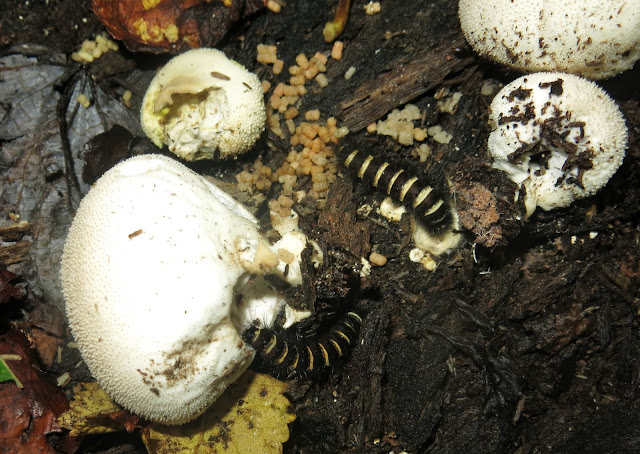 |
Find the bat!
|
 |
Other side of a "leaf"- Click to enlarge |
Mark Bower was picking spicebush berries for a natural spice when he came across a very unusual brown dead leaf, thicker than the others. Thinking it might be a gall or a moth pupa, he touched it and felt fur as it wiggled in his hand. As a highly trained naturalist he immediately concluded it wasn't just a leaf.

Moving to the other side he could see it was a bat. After photographing it he identified it as an eastern red bat (Lasiurus borealis), as later confirmed by Melvin Johnson. According to
Wikipedia, "they spend most of their time year-round on tree leaves or in tree leaves on the ground. They tend to generally be loners as well, and tolerate cold temperatures and snow."

Mark checked it the next day and it was still clinging to the same leaf. When he touched it lightly, it spread its wings....still alive! The question that he now faced was is this a healthy bat? The following day it was gone, suggesting that it had just been sleeping in.
We asked Melvin Johnson again. "It looked fat. Likely wasn't all that hungry the other night. They don't always feed every night. It may be back if it really likes that area and/or location. They can also travel large distances."

Side view, upside down. Note the cute ear.
They spend most of their time year-round on tree leaves or in tree leaf litter on the ground. In the Midwest some may migrate south while others will spend the winter here, nestled up in hollow trees and leaf piles. They are not usually cave dwellers.


So why was Mark picking spicebush berries? To make
cookies! Spicebush (
Lindera benzoin) is a common understory shrub in the Ozarks. Barb calls it the scratch and sniff plant. All parts of spicebush are very aromatic. In early spring it has small yellow flowers. The female plants produce bright red berries in fall. These berries can be used as a substitute for allspice. They are also eaten by many species of birds. When the leaves are crushed they can be used for making tea.

Spicebush swallowtail -
Featured creatures CC
Spicebush is the host plant for both the spicebush swallowtail (SST, aka Papilio troilus) and the eastern tiger swallowtail ((Papilio glaucus). Other species such as the Promethea silkmoth
(Callosamia promethea) feed on the leaves as do deer and other mammals. Our SST is not only a beautiful butterfly but it has one of the cutest caterpillars ever!
 They start out life as incredibly cute little "cats" with stripes and a few tufts of non-stinging hairs. Like many lepidoptera, they may snack on their egg case before finding leaves of oaks, maples, sassafras, or sweetgum. Later instars, like below, develop a spiky look of the punk generation of teens.
They start out life as incredibly cute little "cats" with stripes and a few tufts of non-stinging hairs. Like many lepidoptera, they may snack on their egg case before finding leaves of oaks, maples, sassafras, or sweetgum. Later instars, like below, develop a spiky look of the punk generation of teens. The final instar crawls into the soil and leaf litter to pupate and spend the winter. It comes equipped with a couple of pointed tail pipes that are said to help it dig its way out in the spring before emerging as the full grow silk moth. If you have trouble visualizing it wiggling to the surface, just watch this video of a pupa in action.
The final instar crawls into the soil and leaf litter to pupate and spend the winter. It comes equipped with a couple of pointed tail pipes that are said to help it dig its way out in the spring before emerging as the full grow silk moth. If you have trouble visualizing it wiggling to the surface, just watch this video of a pupa in action.


















